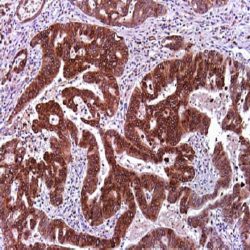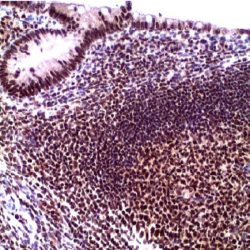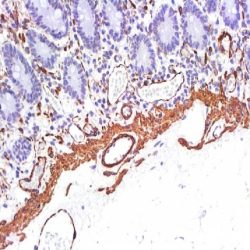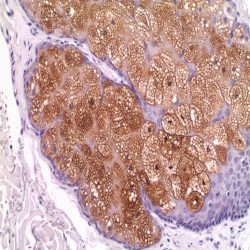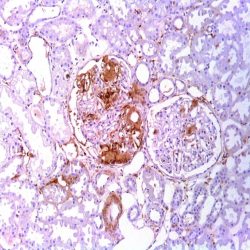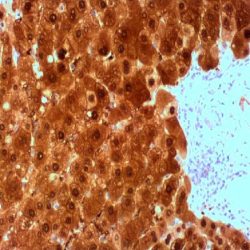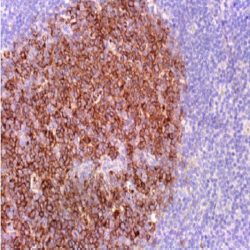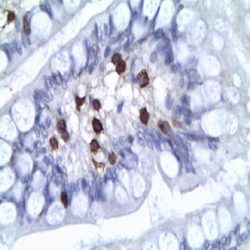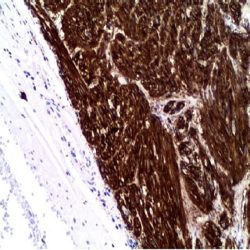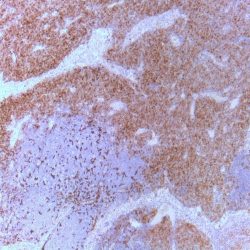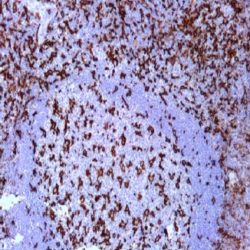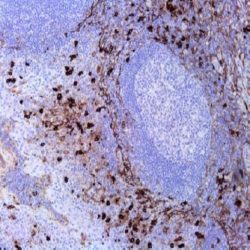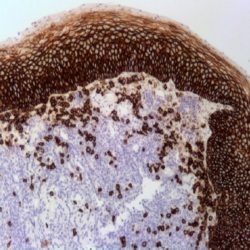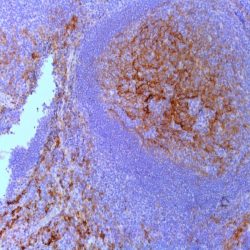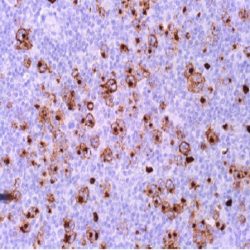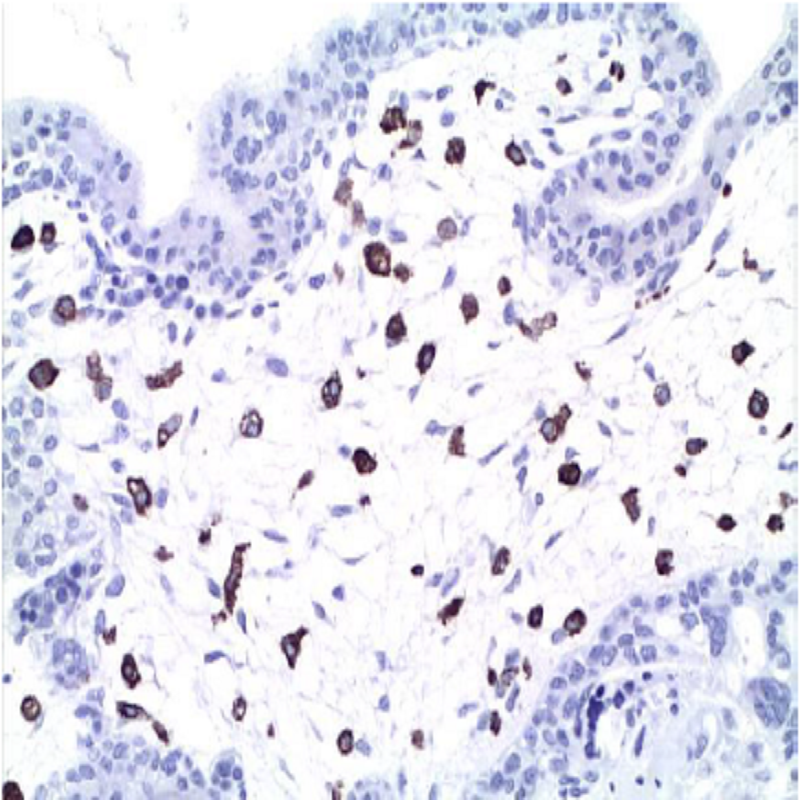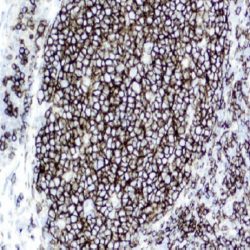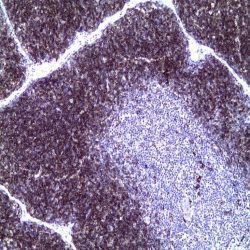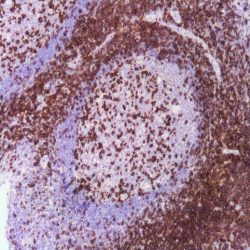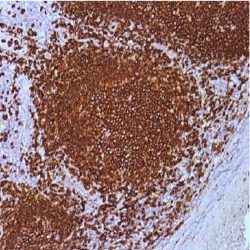آنتی بادیهای ایمونوهیستوشیمی
نمایش 101–120 از 336 نتیجه
فیلتر ها-
آنتی بادیهای ایمونوهیستوشیمی
آنتی بادی COX-2 (SP21)
امتیاز 0 از 5اطلاعات بیشترName: COX2 (Cyclooxygenase 2) Antibody (Clone SP21)
Description and applications: COX-2 (Cyclooxygenase-2) is an inducible enzyme. It is involved in the response of cells to growth factors, tumor promoters, and cytokines that induce its expression. Given its role in synthesizing prostaglandins, COX-2 is therefore of interest in studying immune response regulation. COX-2 is induced by a wide variety of stimuli and was initially identified as immediate-early growth response gene. In addition, COX-2 expression markedly increased in 85-90% of human colorectal adenocarcinoma whereas COX-1 levels remain unchanged. COX-2 is expressed in normal cells from mammary acini, uterine cervix, uterus, fallopian tubes, trophoblast of chorionic villi, prostate, seminal vesicles, epididymis, bladder urothelial epithelium, gastric glands or gallbladder. Consequently, COX-2 is expressed in many solid tumors. Intense to moderate cytoplasmic and sometimes membrane expression is observed in colorectal, prostate, cervical, endometrial, ovarian, urothelial, pancreatic and hepatic carcinomas. COX-2 is frequently expressed in breast carcinomas while up to 80% of pituitary adenomas are positive. The prognostic value of COX-2 expression is controversial.
Composition: anti-human COX2 rabbit monoclonal antibody purified by protein affinity and prepared in 10mM PBS, pH 7.4, with 0.2% BSA and 0.09% sodium azide.
Immunogen: Synthetic peptide corresponding to C-terminus of rat COX-2.
-
آنتی بادیهای ایمونوهیستوشیمی
آنتی بادی INI1 (BAF47/SNF5) (25/BAF47)
امتیاز 0 از 5اطلاعات بیشترName: INI-1 (BAF47/SNF5) Antibody (Clone 25/BAF47)
Description and applications: SWI/SNF complexes facilitate gene activation and transcription factor binding by altering repressive chromatin structures in an ATP-dependent manner. In mammals, SWI/SNF complexes are present in mutliple forms that include 9-12 BRG1-associated factors (BAFs) per complex. These BAF proteins range in molecular weight from 47 to 250 kDa. BAF47/SNF5 (SMARCB1/Ini1) complexes with BRG1- and BRM-containing SWI/SNF complexes. BAF47/SNF5 mRNA is widely expressed in cell lines and tissues, and BAF47/SNF5 gene is mutated in many human tumors. The latter is indicative of a tumor suppressor role for BAF47/SNF5. In addition, mice deficient for BAF47 die early in embryogenesis, while BAF47/SNF5 heterozygous mice display a variety of tumors in the soft tissues of the head and neck. BAF47/SNF5 also binds the HIV-1 integrase and stimulates integrase-mediated DNA joining activity. Thus, BAF47/SNF5 is a component of SWI/SNF complexes that may be critical for normal development and tumor suppression, but may also be a protein utilized for viral DNA integration into host DNA. Expression in normal tissues is ubiquitous. In tumor tissue loss of protein expression SMARCB1 / INI1 gene was first observed in all malignant rhabdoid tumors of childhood of different location (soft tissue, kidney and CNS) and in medullary carcinomas of the kidney. Also loss of expression is observed in 50% of synovial sarcomas, some myxoid chondrosarcoma and myoepithelial carcinomas, almost all epithelioid sarcoma (proximal and conventional variants) and 50% of malignant tumors of peripheral nerves sheat, all presenting rhabdoid morphology. Loss of immunohistochemistry expression is also observed in cases of poorly differentiated chordoma. The antibody is useful in differentiating rhabdoid tumors of other tumors with similar morphology as desmoplastic round cell tumor, rhabdomyosarcoma and Wilms tumor do not show loss of expression of INI1. The antibody also is useful in confirming the diagnosis of medullary carcinoma and discard possible renal pelvis urothelial carcinoma or other carcinomas of the kidney showing expression for INI1. Maintained staining in most carcinomas, epithelioid angiosarcoma, mesotheliomas, melanomas and other tumors or lesions reagents (granulomas) of epithelioid morphology make this useful antibody in the diagnosis of epithelioid sarcoma.
Composition: anti-human INI-1 mouse monoclonal antibody purified from serum and prepared in 10mM PBS, pH 7.4, with 0.2% BSA and 0.09% sodium azide.
Immunogen: mouse BAF47 aminoacids 257-359.
-
آنتی بادیهای ایمونوهیستوشیمی
آنتی بادی Actin, Muscle Specific (HHF35)
امتیاز 0 از 5اطلاعات بیشترName: Muscle Specific Actin,Antibody (Clone HHF35)
Description and applications: Actin is a major component of the cytoskeleton. This antibody recognizes actin of skeletal, cardiac, and smooth muscle cells. It is not reactive with other mesenchymal cells except for myoepithelium. Actin can be resolved on the basis of its isoelectric points into three distinctive components: alpha, beta and gamma in order of increasing isoelectric point. Anti- Muscle-Specific Actin recognizes alpha and gamma isotypes of all muscle groups. Non-muscle cells such as vascular endothelial cells and connective tissues are non-reactive. Also, neoplastic cells of non-musclederived tissue such as carcinomas, melanomas, and lymphomas are negative. This antibody is useful in the identification of rhabdoid cellular elements.
Composition: anti-human Muscle Specific Actin mouse monoclonal antibody purified from serum and prepared in 10mM PBS, pH 7.4, with 0.2% BSA and 0.09% sodium azide.
Immunogen: SDS extract of human myocardium
-
آنتی بادیهای ایمونوهیستوشیمی
آنتی بادی Adipophilin (Polyclonal)
امتیاز 0 از 5اطلاعات بیشترName: Adipophilin Antibody (Polyclonal)
Description and applications: Sebaceous carcinoma is a relatively uncommon cutaneous malignancy and mimics other malignant neoplasms, such as basal and squamous cell carcinomas, and benign processes, such as chalazions and blepharitis, sometimes resulting in delayed diagnosis and suboptimal treatment. Adipophilin is present in milk fat globule membranes and on the surface of lipid droplets in various normal cell types. Recently, it has been reported that adipophilin was expressed in sebaceous adenomas with a specific pattern: membranous with strong uptake at the periphery of intracytoplasmic lipid vacuoles. Sebaceous carcinomas are also labeled with a similar pattern. Additionally, in cases of poorly differentiated sebaceous carcinoma, adipophilin highlights the sebocytes with a strong membranous labeling of intracytoplasmic lipid droplets. Moreover, xanthelasmas, xanthogranulomas, xanthomas, metastatic renal cell carcinomas were also weakly-to- moderately positive for adipophilin in one study. Expression of adipophilin with a membranous pattern of staining was not seen in any of the other clear cell lesions of the skin, including basal and squamous cell
carcinomas, trichilemmomas, clear cell hidradenomas,or balloon cell nevi. Interestingly, a nonspecific granular uptake of anti-adipophilin was seen in adjacent macrophages, keratohyalin granules of epithelial squamous cells, and some tumor cells.Therefore, this anti-adipophilin is suitable for immunostaining formalin-fixed, paraffin-embedded tissue and is helpful in the identification of intracytoplasmic lipids, as seen in sebaceous lesions. Acinary cell carcinomas of the breast, some liposarcomas, or carcinomas of the colon, lung, pancreas or prostate and strangely the majority of Burkitt lymphomas might also be positive.
Composition:Anti-human Adipophilin rabbit polyclonal antibody purified from serum and prepared in 10mM PBS, pH 7.4, with 0.2% BSA and 0.09% sodium azide.
-
آنتی بادیهای ایمونوهیستوشیمی
آنتی بادی Amyloid P (EP1018Y)
امتیاز 0 از 5اطلاعات بیشترName: Amyloid P Antibody clone EP1018Y
Description and applications: Serum Amyloid P (SAP) is a non-fibrillar plasma glycoprotein that belongs to the pentraxin family. It is universally found in amyloid deposits and this is probably due to its specific calcium-dependent binding to motifs present on all types of amyloid fibrils. SAP is also found to prevent fibrillar breakdown by enzymes and it is believed that it helps maintains stability of the amyloid deposits. It has been shown that SAP binds monocytes with high avidity, but does not bind to erythrocytes, NK cells, T lymphocytes or B lymphocytes. SAP production can be induced by exposure to IL-1, IL-6 and IFN-beta. The SAP-inducing activity was neutralized by antibodies to each of the recombinant cytokines. Recognition of these type of amyloid has prognostic and therapeutic implications. The increase in SAP secretion has been documented in different pathologies including neoplasms, rheumatoid arthritis
and CNS diseases. The synthesis of SAP is increased in systemic amyloidosis and is a common component in amyloid deposits. SAP has also been identified in arteriosclerotic lesions.Composition: Anti-human Amyloid P rabbit monoclonal antibody purified from serum and prepared in 10mM PBS, pH 7.4, with 0.2% BSA and 0.09% sodium azide.
-
آنتی بادیهای ایمونوهیستوشیمی
آنتی بادی ARG-1 (EP261)
امتیاز 0 از 5اطلاعات بیشترName: Arginase-1 Antibody (Clone EP261)
Description and applications: Arginase is a manganese metalloenzyme that catalyzes the hydrolysis of arginine to generate ornithine and urea. Arginiase I and II are isoenzymes which differ in subcellular localization, regulation, and possibly function. Arginase I is a cytosolic enzyme, which is expressed mainly in the liver as part of the urea cycle, whereas arginase II is a mitochondrial protein found in a variety of tissues. Antibody to ARG-1 labels hepatocytes in normal tissues and granulocytes in peripheral blood. ARG-1 is a sensitive and specific marker for identification of hepatocellular carcinoma. This antibody is very useful in distinguishing between: 1) liver metastases of various adenocarcinomas and hepatocellular carcinoma (HCC), which can be a realdiagnostic challenge, especially in small biopsies or material from fine needle aspiration ( FNA) and 2) the distinction between different histological variants of HCC and cholangiocarcinoma. Specifically, the ARG-1 antibody is key in the diagnosis of scirrhous hepatocellular carcinoma, where specific markers for adenocarcinomas are generally positive while HepPar-1 in some cases it may be negative. In addition, several studies have shown that ARG-1 antibody is more sensitive than HepPar-1 for immunohistochemical diagnosis of hepatocellular carcinoma while the second is usually negative in poorly differentiated hepatocellular carcinomas and can be positive in adenocarcinomas of pancreatic, gastric, colic origin or even cholangiocarcinoma. However, isolated cases of pancreatic adenocarcinomas and cholangiocarcinomas presented focal staining against ARG-1. In this line, it should be considered that the ARG-1 antibody does not allow differential diagnosis between benign, dysplastic and malignant hepatocyte lesions.
Composition: anti-human ARG-1 rabbit monoclonal antibody purified from serum and prepared in 10mM PBS, pH 7.4, with 0.2% BSA and 0.09% sodium azide.
-
آنتی بادیهای ایمونوهیستوشیمی
آنتی بادی CD10 (56C6)
امتیاز 0 از 5اطلاعات بیشترName: CD10 Antibody (Clone 56C6)
Description and aplications: CD10, also known as Common Acute Lymphocytic Leukemia Antigen (CALLA), is a cell surface enzyme with neutral metalloendopeptidase activity which inactivates a variety of biologically active peptides. CD10 is expressed on the cells of lymphoblastic, Burkitt’s, and follicular germinal center lymphomas, and on cells from patients with chronic myelocytic leukemia (CML). It is also expressed on the surface of normal early lymphoid progenitor cells, immature B cells within adult bone marrow and germinal center B cells within lymphoid tissue. CD10 is also present on breast myoepithelial cells, bile canaliculi, fibroblasts, with especially high expression on the brush border of kidney and gut epithelial cells.
Composition: anti-human CD10 mouse monoclonal antibody purified from ascites fluid by Protein A chromatography. Prepared in 10mM PBS, pH 7.4, with 0.2% BSA and 0.09% sodium azide.
-
آنتی بادیهای ایمونوهیستوشیمی
آنتی بادی CD103 (EP206)
امتیاز 0 از 5اطلاعات بیشترName: CD103 Antibody (Clone EP206)
Description and applications: CD103, also known as integrin alpha E (ITGAE), is an integrin protein that in humans is encoded by the ITGAE gene. It binds integrin beta 7 to form the complete heterodimeric molecular αEβ7 that binds to an extracellular matrix component and cellular counter receptor. They mediate cell adhesion, migration and signaling and are important for T lymphocyte localization. CD103 is expressed on intraepithelial lymphocytes in mucosal areas, including lung and GI tract. In malignancies, CD103 is present on all enteropathy-type T-cell lymphomas. Additionally, CD103 has been a useful marker for hairy cell leukemia.
Composition: anti-human CD130 rabbit monoclonal antibody purified from ascites. Prepared in 10mM PBS, pH 7.4, with 0.2% BSA and 0.09% sodium azide.
-
آنتی بادیهای ایمونوهیستوشیمی
آنتی بادی CD117/c-kit (EP10)
امتیاز 0 از 5اطلاعات بیشترName: CD117/c-kit Antibody (Clone EP10)
Description and applications: This antibody reacts with human oncoprotein c-kit (CD117). The proto-oncogene c-kit encodes a transmembrane receptor with tyrosine kinase activity, c-kit (CD117), which is closely related to the family of platelet derived growth factor receptors. c-KIT is involved in hematopoiesis, gametogenesis and melanogenesis. This antigen is expressed in the normal breast epithelium, melanocytes, mast cells and glia. This antibody is recommended to identify oncoprotein expression c-kit in a variety of normal and neoplastic tissues, including gastrointestinal stromal tumors (GIST). It is also expressed in testicular seminoma, small cell carcinomas of the lung, breast carcinomas, glioblastomas, melanomas, and chronicmyeloid leukemias or acute myeloid leukemias in myeloid blast crisis.
Composition: anti-human CD117/c-kit rabbit monoclonal antibody purified from ascites. Prepared in 10mM PBS, pH 7.4, with 0.2% BSA and 0.09% sodium azide.
-
آنتی بادیهای ایمونوهیستوشیمی
آنتی بادی CD11b (Integrin Alpha-M) (EP45)
امتیاز 0 از 5اطلاعات بیشترName: CD11b (Integrin Alpha-M) Antibody (Clone EP45)
Description and applications: Integrin alpha-M (ITAM, ITGAM, CD11b, Mac-1 alpha subunit, C3 alpha chain) is the alpha subunit of the ITAM/beta-2 complex, also named CD11b/CD18 or Mac-1, a leukocyte adhesion heterodimeric glycoprotein. CD11b is involved in monocyte, macrophage, and granulocyte adhesion. CD11b is mainly expressed in myeloid cells of human origin, NK1 cells, monocytes, and granulocytes. In neoplasms, CD11b is useful for the identification of acute myeloid leukaemias (AML) (AML with inv(16) or t(16;16), AML with 11q23/MLL abnormalities, myeloblastic AML with minimal differentiation, myelomonocytic AML, acute monoblastic leukaemia, and acute monocytic leukaemia), where blasts may express CD11b among other molecules of monocytic differentiation. CD11b is also expressed in T-cell large granular lymphocyte leukaemias and in aggressive NKcell leukaemias.
Composition: Anti-human CD11b (Integrin Alpha-M) rabbit monoclonal antibody purified from serum and prepared in 10mM PBS, pH 7.4, with 0.2% BSA and 0.09% sodium azide.
-
آنتی بادیهای ایمونوهیستوشیمی
آنتی بادی CD11c (Integrin Alpha-X) (EP157)
امتیاز 0 از 5اطلاعات بیشترName: CD11c (Integrin Alpha-X) Antibody (Clone EP157)
Description and applications: CD11c (ITGAX), a member of the leukointegrin family, shares the same beta subunit with other members of the leukocyte adhesion molecule family, which includes CD11a (LFA-1), CD11b (MAC-1) and CD11d (ITGAD), but has a unique alpha chain. CD11c has been shown to play a role in phagocytosis, cell migration, and cytokine production by monocytes/macrophages as well as induction of T cell proliferation by Langerhans cells. CD11c is expressed prominently on the plasma membranes of monocytes, tissue macrophages, NK cells, and most dendritic cells (DCs). A lower level of expression is also observed on neutrophils as a result of its high level of expression on most DCs. An antibody to CD11c may aid in identification of lesions with histiocytic origin. It may also been used as a marker for hairy cell leukaemia in paraffin embedded tissues.
Composition: anti-human CD11c rabbit monoclonal antibody purified from serum and prepared in 10mM PBS, pH 7.4, with 0.2% BSA and 0.09% sodium azide.
-
آنتی بادیهای ایمونوهیستوشیمی
آنتی بادی CD13 (EP117)
امتیاز 0 از 5اطلاعات بیشترName: Rabbit anti-human CD13 Monoclonal Antibody
Composition: anti-human CD13 rabbit monoclonal antibody purified from ascites fluid by chromatography. Prepared in 10mM PBS, pH 7.4, with 0.2% BSA and 0.09% sodium azide
Intended use: Immunohistochemistry (IHC) on paraffin embedded tissues. Not tested on frozen tissues or Western-Blotting
Immunogen: A synthetic peptide corresponding to residues in human CD13 protein
Visualization: Cell membrane
-
آنتی بادیهای ایمونوهیستوشیمی
آنتی بادی CD138 (EP201)
امتیاز 0 از 5اطلاعات بیشترName:CD138 Antibody clone EP201
Description and applications: CD138, also known as Syndecan-1, is a member of the transmembrane heparan sulfate proteoglycan family, acts as an extracellular matrix receptor and is involved in many cellular functions, including cell-cell adhesion and cell-matrix adhesion. CD138 expression is found in both hematopoietic and non-hematopoietic cells. In the hematopoietic system, CD138 labels plasma cells. It is an excellent marker for plasmacytic differentiation within the spectrum of hematologic malignancy. It´s a very usefull tool in the diagnostic of chronic endometritis associated with infertility. Among nonhematolymphoid cells, CD138 reactivity is observed inmany types of epithelial cells and stoma cells in both normal and tumor tissues. These staining should
be remembered and not interpreted as unspecific.Composition:Anti-human CD138 rabbit monoclonal antibody purified from serum and prepared in 10mM PBS, pH
7.4, with 0.2% BSA and 0.09% sodium azideIntended use: Immunohistochemistry (IHC) on paraffin embedded tissues. Not tested on frozen tissues or Western-Blotting
-
آنتی بادیهای ایمونوهیستوشیمی
آنتی بادی CD14 (EP128)
امتیاز 0 از 5اطلاعات بیشترName: CD14 Antibody (Clone EP128)
Description and applications:CD14 is a 55-kDa protein found as a glycosylphosphatidylinositol (GPI)- anchored protein on the surface of monocytes, macrophages, and polymorphonuclear leukocytes, and as a soluble protein in the blood. Its main function is to serve as a receptor for lipopolysaccharide (LPS). Besides its role in endotoxin signaling, it has been proposed that CD14 is involved in the transportation of other lipids, cell-cell interactions during different immune responses, and recognition of apoptotic cells.
CD14 is highly expressed on the surface of monocytes/macrophages and strongly up-regulated during the differentiation of monocytic precursor cells into mature monocytes. Therefore, CD14 has been commonly used as a differentiation marker for monocytes/macrophages. An antibody to CD14 also labels Langerhans cells and dendritic cells.Composition: Anti-human CD14 rabbit monoclonal antibody purified from serum and prepared in 10mM PBS, pH 7.4, with 0.2% BSA and 0.09% sodium azide.
-
آنتی بادیهای ایمونوهیستوشیمی
آنتی بادی CD15 (MMA)
امتیاز 0 از 5اطلاعات بیشترName: CD15 Antibody (Clone MMA)
Description and aplications: This antibody reacts against the human antigen CD15 (fucosyltransferase 4) also known as Lewis X (Lex); 3-fucosyl-Nacetyllactosamine [3-FL]; X hapten; specific embryonic antigen-1 to step [SSEA-1]; lacto-N-fucopentaose III
[LNFP III]. This antibody is expressed in normal myelomonocytic cells (90% of human neutrophil granulocytes in peripheral blood and lymphoid and 30% – 60% of circulating monocytes), not being present in normal lymphocytes. CD15 is consistently expressed by the
epithelial cells of renal tubules, gastric glandular epithelium, tonsil and esophageal squamous epithelium, ductal epithelium of salivary glands, pancreas and mammary ducts, thymus Hassall corpuscles, gray and white matter and in endocrine cells of the adrenal cortex and anterior pituitary. In neoplasms, CD15 antigen is expressed by the Reed- Sternberg cells of classic Hodgkin lymphoma (membrane pattern and / or Golgi area), in some leukemias (acute and chronic myeloid leukemia (> 50%), acute myelogenous leukemia (> 95% of chronic phase and> 50% blast phase), and in carcinomas derived from organs whose cells are positive for CD15, including adenocarcinomas of kidney, digestive tract, squamous cell carcinomas. The CD15 may be useful in confirming the diagnosis of Hodgkin’s disease and the differential diagnosis of mesothelioma (usually negative) and lung adenocarcinoma (usually positive).Composition: anti-human CD15 mouse monoclonal antibody purified from ascites fluid by Protein A chromatography. Prepared in 10mM PBS, pH 7.4, with 0.2% BSA and 0.09% sodium azide.
-
آنتی بادیهای ایمونوهیستوشیمی
آنتی بادی CD163 (EP324)
امتیاز 0 از 5اطلاعات بیشترName: CD163 Antibody (Clone EP324)
Description and aplications: CD163 was recently identified as an acute phase-regulated transmembrane protein whose function is to mediate the endocytosis of haptoglobin-hemoglobin complexes. This receptor is expressed on the surface of monocytes (low expression) and tissue macrophages [also known as histiocytes] (high expression). It is a member of the cysteine-rich scavenger receptor superfamily, encoded by a gene localized on human chromosome 12p13.3. Solubilized in plasma, CD163 functions as an anti-inflammatory signal and has many roles in disease processes that range from autoimmune conditions such as rheumatoid arthritis to atherosclerosis. Previous work has shown that the CD163 gene can be regulated by glucocorticoids, IL-10, and other inflammatory modulators, and is highly expressed in inflamed tissues, consistent with its role in the resolution of inflammation.
Staining for CD163 has been helpful in distinguishing synovial macrophages from synovial intimal fibroblasts in the setting of rheumatoid arthritis,where its specificity for macrophages was found to be superior to that of CD68, which does not discriminate between these cell types. Increased levels of CD163 were also detected in patients with microbial infections and myelomonocytic leukemias by an enzyme-linked immunosorbent assay. Flow cytometry studies have confirmed that CD163 expression is limited to leukemias with monocytic differentiation. Another recent study showed that all 5 cases of synovial-type giant cell tumors of the vertebral column stained for CD163.Composition: anti-human CD163 mouse monoclonal antibody obtained from supernatant. Prepared in 10mM PBS, pH 7.4, with 0.2% BSA and 0.09% sodium azide.
-
آنتی بادیهای ایمونوهیستوشیمی
آنتی بادی CD19 (SP110)
امتیاز 0 از 5اطلاعات بیشترName: CD19 Antibody (Clone SP110)
Description and aplications: This antibody recognizes the CD19, a surface glycoprotein of 95 kD which is present in both malignant and normal B cells which was always been considered as the most reliable surface marker of this cell line, within all range of stages of maturation. In the normal lymphoid tissue, the CD19 staining appears in germinal centers (follicular dendritic cells and B cells) in the mantle zone and as scattered cells within the interfollicular areas with overlapping patterns of immunostaining with CD20 and CD22 cells. However, in contrast to CD20, CD19 is also expressed on pre-B cells. CD19 was detected by flow cytometry in extramedullary plasma cells isolated from human tissue. CD19 positivity appears in the vast majority of B cell neoplasms while the plasma cell neoplasms are always negative. No CD19 stain was detected in Reed- Sternberg cells of Hodgkin’s disease.
Composition: anti-CD19 mouse monoclonal antibody obtained from supernatant culture and prediluted in a tris buffered solution pH 7.4 containing 0.375mM sodium azide solution as bacteriostatic and bactericidal.
-
آنتی بادیهای ایمونوهیستوشیمی
آنتی بادی CD1a (EP80)
امتیاز 0 از 5اطلاعات بیشترName : Rabbit anti-human CD1a Monoclonal Antibody clone EP80
Description and applications: Cluster of Differentiation 1a (CD1a) is part of a family of major histocompatibility complex (MHC) antigen-like glycoproteins that associate with beta-2- microglobulin. CD1a binds self and non-self lipid and glycolipid antigens, presenting them to T-cell receptors on natural killer T-cells. CD1a antibody labels cortical thymocytes, Langerhans’ cells and dendritic cells. It has been used to identify Langerhans’ cell histiocytosis and precursor T lymphoblastic lymphoma/leukemia.
Composition: Anti-human CD1a rabbit monoclonal antibody purified from serum and prepared in 10mM PBS, pH 7.4, with 0.2% BSA and 0.09% sodium azide
Intended use: Immunohistochemistry (IHC) on paraffin embedded tissues. Not tested on frozen tissues or Western-Blotting
Immunogen: A synthetic peptide corresponding to residues in human CD1a protein.
-
آنتی بادیهای ایمونوهیستوشیمی
آنتی بادی CD2 (EP222)
امتیاز 0 از 5اطلاعات بیشترName: CD2 Antibody Clone EP222
Description and applications: T-cell surface antigen CD2 (CD2) is a T-cell specific surface glycoprotein that is critically important for mediating adherence of T cells to antigen-presenting cells or target cells. It interacts with lymphocyte functionassociated antigen (LFA-3) and CD48/BCM1 to mediate adhesion between T-cells and other cell types. CD2 is involved in triggering T-cells, and the cytoplasmic domain is involved in signaling. CD2 is a pan T-cell marker. CD2 antibody labels T-cell, thymocytes and natural killer (NK) cells. CD2 is absent in a small subset of T cells. CD2 antibody is useful for identification of precursor and mature T-cell lymphomas. Aberrant loss of CD2 in T-cell lymphomas may helpful to distinguish them from reactive T-cell proliferations.
Composition: Anti-human CD2 rabbit monoclonal antibody purified from serum and prepared in 10mM PBS, pH 7.4, with 0.2% BSA and 0.09% sodium azide.
Immunogen:human CD2 recombinant protein.
-
آنتی بادیهای ایمونوهیستوشیمی
آنتی بادی CD20 (L26)
امتیاز 0 از 5اطلاعات بیشترName: Mouse Anti-CD20 Monoclonal Antibody clone L26
Description and aplications: CD20 is a non-Ig differentiation antigen of B cells and the expression of CD20 is restricted to normal and neoplastic B cells, being absent from all other leukocytes and tissues. It acts as calcium channel involved in B cell activation and cell cycle progression. The antibody is useful for identifying B cell lymphoid malignancies, whether non-Hodgkin lymphoma, acute or chronic B lymphocytic leukemias and hairy cell leukemia. Also, the anti-CD20 antibody stains the tumor cells of Hodgkin’s disease nodular lymphocytepredominant subtype and occasionally, the Reed- Sternberg cells of other histologic variants of classic Hodgkin’s disease.
Composition: anti-CD20 mouse monoclonal antibody obtained from supernatant culture and prediluted in a tris buffered solution pH 7.4 containing 0.375mM sodium azide solution as bacteriostatic and bactericidal.
Immunogen: Human tonsil B cells.

